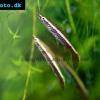Dwarf pencilfish - Nannostomus marginatus
Scientific name: Nannostomus marginatus
Common name: Dwarf pencilfish
Family: Lebiasinidae
Usual size in fish tanks: 3 - 4 cm (1.18 - 1.57 inch)
014
Recommended pH range: 5.8 - 7.3
Recommended water hardness: 14 - 20°N (250 - 357.14ppm)
0°C 32°F30°C 86°F
Recommended temperature range: 24 - 27 °C (75.2 - 80.6°F)
The way how these fish reproduce: Spawning
Where the species comes from: South America
Temperament to its own species: peaceful
Temperament toward other fish species: peaceful
Usual place in the tank: Middle levels
Origin
South America; Dwarf pencilfish are to be found in the Amazonian River Basins. Markings and colouration may vary slightly dependant on which locality they originate from.
Lifespan
The expected life span for Dwarf pencilfish is 2-5 years.
Short description
A planted tank should be used for Nannostomus marginatus with subdued lighting. They prefer black water conditions, the addition of new bogwood which will release tannins will help in this. In the wild they inhabit slow moving waters so this will need to be replicated in the aquarium by keeping the water flow at a low level. Add plenty of plants and also floating plants to help diffuse the lighting. A dark substrate will also help to bring out the best colouration in the fish. They should never be added to an aquarium that has not matured as they do require stable water conditions and bounces in the water parameters will be detrimental to their long term health.
They are a very skittish species and need to be kept in groups of at least 10 specimens, this will make them feel more secure in the aquarium, they cannot compete with other tank mates so only house the Dwarf pencilfish with other peaceful species.
Food and feeding
Precautions should be taken when feeding as this fish is a nervous species and may not get its fair share of food if kept with bold tank mates. It will accept quality flake, small live or frozen foods. It is advised that offering two small meals per day is far better than offering one large meal so that they can digest their food properly due to their small size.
Sexing
Adult males will be more slender than the females, they will also have a reddish tint to their fins, and this is not present in the females.
Breeding
Fine leaved plants or Java moss should be added to the tank, the water should be soft and acidic. They will scatter the eggs around the tank and 2 days later the fry should hatch out. When the fry are free swimming, they can be fed on Infusoria or rotifers. The parent fish will need to be removed when the eggs have been fertilised or there is a very high risk of the eggs being eaten. It is best to grow on the fry in a separate tank to rule out any risk of being predated upon and they should all grow at the same rate but make sure that the tank is filled with aged water and that water changes are small but performed on a daily basis.
Picture
Bought by aqua-fish.net from jjphoto.dk.


 Splashing
Splashing  Brown
Brown  Coral-red
Coral-red  Threestripe
Threestripe